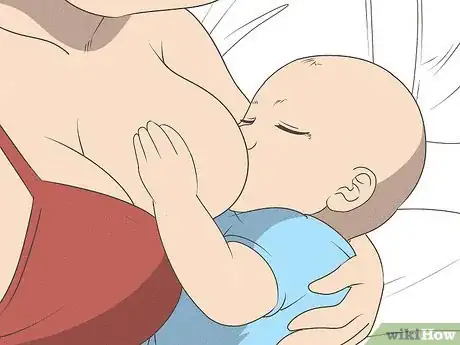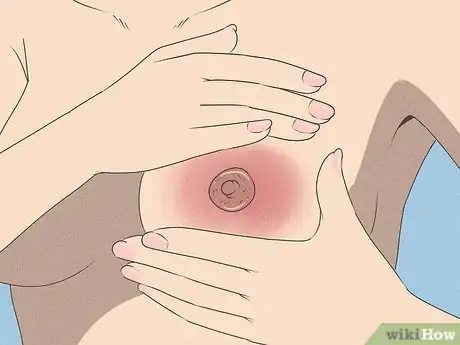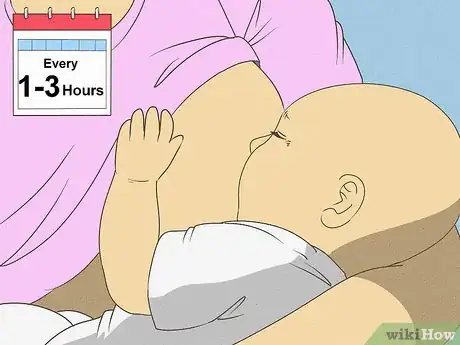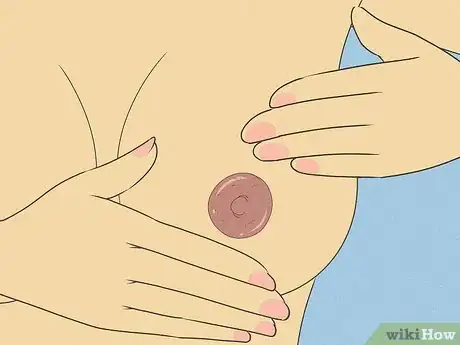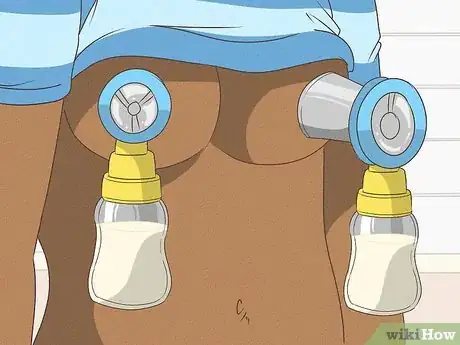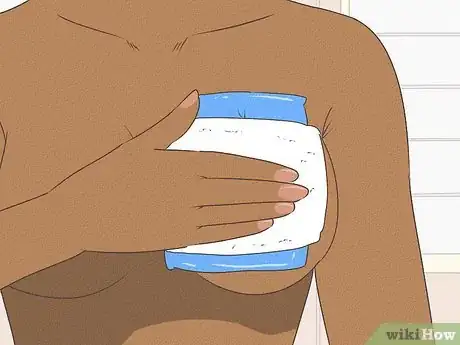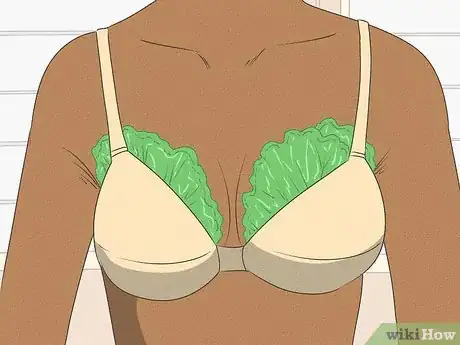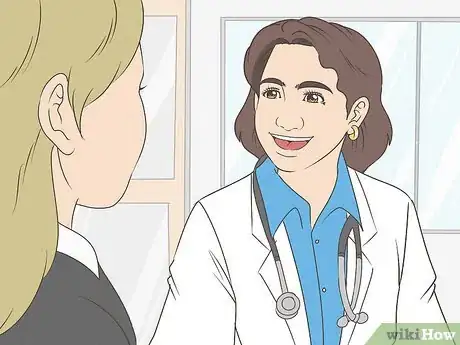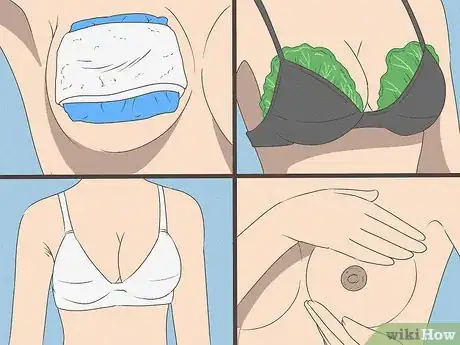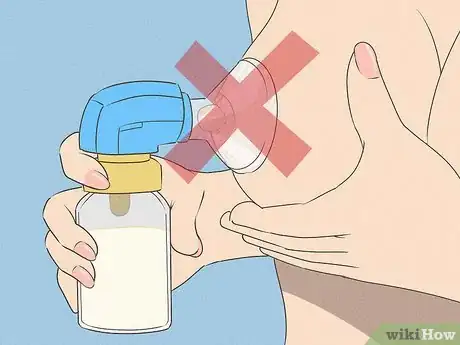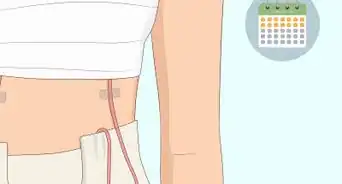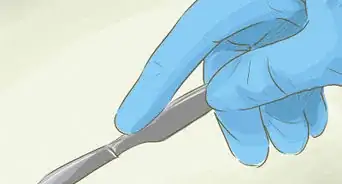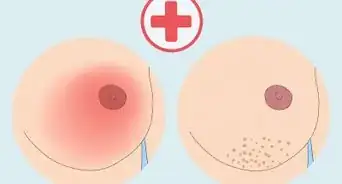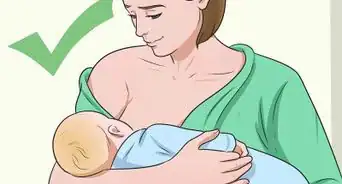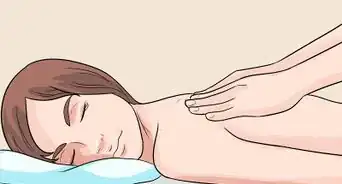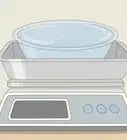This article was medically reviewed by Lacy Windham, MD. Lacy Windham, MD, is a Board-Certified Obstetrician & Gynecologist in Cleveland, Tennessee. Dr. Windham attended medical school at the University of Tennessee Health Science Center in Memphis. Her residency was completed at Eastern Virginia Medical School in Norfolk, Virginia. She was the recipient of multiple awards during her residency training, including Most Outstanding Resident in Maternal Fetal Medicine, Most Outstanding Resident in Oncology, Most Outstanding Resident Overall, and Special Award in Minimally Invasive Surgery.
There are 8 references cited in this article, which can be found at the bottom of the page.
This article has been viewed 331,956 times.
Breast engorgement is a condition that affects nearly all new mothers within the first few weeks of giving birth. It can also happen in the process of weaning off of breastfeeding. The condition is painful and, if not treated, can lead to other conditions such as plugged milk ducts and breast infection (called "mastitis"). Fortunately, there are things you can do to help relieve it.
Steps
Recognizing Symptoms of Breast Engorgement
-
1Understand what causes breast engorgement. It is caused by an imbalance between milk supply and infant demand. In other words, your breasts are producing more milk than is being consumed by your baby.
- Breast engorgement can occur in the early days of breastfeeding, as your body is establishing how much milk needs to be stored in order to feed your baby.
- Breast engorgement can also occur when you are weaning off of breastfeeding, and even night-weaning. As you diminish your baby's consumption of milk, your breasts will take some time to adjust and to produce less milk.[1]
- It can also occur when your baby is sick, as he or she will tend to feed less during these times.
- Finally, breast engorgement is common in women who have chosen not to breastfeed, as their breasts adjust to the fact that they will not need to continue producing milk.
-
2Know the symptoms of breast engorgement. When your breasts first begin to make milk after you deliver your baby, they may feel warm, swollen, and heavy, even uncomfortably so. Symptoms of prolonged breast engorgement after the first 2-5 days include:
- breasts that are swollen, firm, and painful
- flattened, hard areolas (the darker part of the breast around the nipple). This can make it more challenging for the baby to latch on.
- breasts that seem shiny, warm, hard, or slightly lumpy to the touch (in more severe cases)
- a slight fever and/or enlarged lymph nodes in the armpits
Advertisement -
3Learn about complications of breast engorgement and when to seek help. If you find the soreness of your breasts is worsening, or you notice redness or lumpiness to the skin, or pain or burning when feeding, you may have plugged milk ducts or "mastitis" (an infection of the breast). [2]
- Plugged milk ducts generally means symptoms of redness, lumpiness, and/or increased pain in the breast secondary to too much milk. It is basically a more serious form of breast engorgement, and you are also more prone to developing an infection in the breast when you have poor milk flow (called "mastitis").[3]
- Plugged ducts can also occur for other reasons (where the duct is truly blocked by something else, other than just milk), but this is less common.
- If you suspect you may have plugged milk ducts or mastitis (both have similar symptoms, but mastitis usually has the added symptom of a fever and/or chills), it is important to see your doctor promptly for treatment. You may need to take an antibiotic.
- If you do not treat mastitis promptly, it can turn into an abscess that could require disfiguring surgery to treat.
Treating Engorgement in Breast-Feeding Women
-
1Nurse your baby regularly. Breast engorgement results from over-production of milk or under-feeding by the baby. The easiest, and quickest, way to alleviate breast engorgement is feeding your baby from the breast that is engorged.[4]
- Most doctors will advise a new mother to nurse her baby every 1 to 3 hours. Breast engorgement can be diminished if you follow this schedule.
- Feed your newborn whenever he is hungry. Don't attempt to put a newborn baby on a feeding schedule.
-
2Ensure your breasts are soft prior to feeding. This allows maximum delivery of milk to your baby. Gently massage the sore spots to soften them. You can do this before and during feeding. A warm compress applied before breast-feeding can also help.
- Don't apply a warm compress for more than 5 minutes. If your engorgement is due to edema (fluid retention), using a warm compress for too long could make the problem worse.
- Many women use a pump or their hand to "express" (remove) excess milk before beginning a breastfeeding session. This will make it easier for your baby to latch onto the breast, and will maximize the amount of milk he can drink (which will in turn reduce pressure and discomfort in your breasts).
-
3Use a pump to remove breastmilk if your baby can't feed (such as during an illness). This allows you to keep to your daily routine, and you can store this breastmilk in the freezer for another time.
- Your breasts will have gotten used to producing a certain amount of milk each day, so it is important to stick to your routine of emptying your breasts regularly in order to prevent them from becoming more engorged.
- Oftentimes, pumped milk that is stored can come in handy at other times. For example, if you have to be away from your baby for any reason, someone else can feed your baby the pumped milk during your absence and it will ensure that he stays on the same breastfed diet.
-
4Take a warm shower. Taking a warm shower triggers something called the "let-down reflex," which actually causes some of the excess milk to leak out. This, in turn, softens your breast and reduces discomfort.[5]
- Allow the spray to start at the top of the breasts and adjust your body so it works its way down. You can also massage them at the same time. This will be a bit painful at first, but it will ease the tenderness and hardness in the breasts.
- You can also fill two bowls with warm water. Place them on a stable surface, such as a table or countertop. Lean over and allow your breasts to soak in the warm water for a few minutes.
-
5Use cold compresses between feedings or breast pumping.[6]
- Try cold compresses to help reduce swelling and ease the pain if your breasts still feel painful and are hard to the touch, even after nursing or pumping milk. Apply the compress several times for up to 15 minutes. Bags of frozen vegetables work well for this method. Make sure to wrap the compress or bag in a light towel to protect your skin.
-
6Try cabbage leaves. Cold cabbage leaves applied against your breasts is an age-old natural remedy that can reduce breast engorgement.
- Place the cold cabbage leaves around your breasts and leave them against your skin for approximately 20 minutes at a time, as needed.
- Note that cabbage leaves should not be placed against broken or irritated skin, as this can worsen the condition. Only use this method if you have simple breast engorgement with no other complications.
-
7Wear a loose-fitting bra. Tight-fitting bras can compress the lower part of the breast to the rib cage. This has the effect of trapping milk in the lower milk ducts and will aggravate the problem.[7]
-
8Use medication to ease the pain and inflammation. You can get ibuprofen (Advil or Motrin) or acetaminophen (Tylenol) over-the-counter at any pharmacy. These are safe to use while continuing to breastfeed your baby.[8]
- Follow the directions on the bottle, and use as needed to reduce pain and discomfort in your breasts.
-
9Seek additional help if needed. Consult your family doctor or a lactation consultant (someone who helps mothers learn to breastfeed) if you would like additional support and guidance in how to manage breast engorgement.
- If you have increasing soreness, hardness, redness, and/or discomfort in your breasts, especially if associated with a fever as well, seek help from your physician promptly. It could be an infection of the breasts (called "mastitis") from blocked milk ducts, which requires antibiotic treatment.
Treating Engorgement When Weaning, and in Non-Breast-Feeding Women
-
1Learn about strategies to reduce discomfort in your breasts. If you have started weaning from breastfeeding, or have decided not to breastfeed in the first place, it will take your breasts a few days to adjust to this. Normally it takes between 1-5 days for your breasts to adjust to the reduced (or absent) demand for milk, and to begin producing less (or not producing milk altogether). Until then, here are some strategies to try:
- applying cold compresses to the breasts
- wearing a loose-fitting bra
- trying cold cabbage leaves
- pumping or using your hand to remove a little bit of the excess milk (note that it is important not to remove too much, or this will stimulate your breasts to produce more milk; however, a small amount is okay).
-
2Avoid pumping if you can. Although a little bit of pumping if you are in a lot of pain can sometimes be of help, in general it is a bad strategy as it encourages your breasts to produce more milk. This can exacerbate the problem rather than solve it.
- Whether you are weaning off of breastfeeding, or not breastfeeding to begin with, trust that if you give your breasts the signal "less (or no) milk is needed right now" by resisting the urge to pump, they will adjust to produce only the required amount of milk.
-
3Avoid certain things when dealing with breast engorgement. These include:
- Heat or warmth to the breasts, as this encourages milk production.
- Stimulation or massage to your breasts, as this also encourages milk production.[9]
-
4Try medication. Use ibuprofen (Advil or Motrin) or acetaminophen (Tylenol) as needed to alleviate pain and discomfort in the breasts. These are available over-the-counter at any pharmacy.
Warnings
- Breast engorgement normally appears within the first couple of days to a week after giving birth. If you experience this condition after you have established a good feeding routine with your baby, it could be something more serious and you should see your doctor.⧼thumbs_response⧽
- Although doctors used to prescribe a drug to "dry up milk," physicians usually no longer prescribe these drugs as the side effects can be very severe.[11]⧼thumbs_response⧽
Things You'll Need
- Breast pump
- Ice packs or compresses
- Loose-fitting bra
- Cabbage leaves
References
- ↑ http://www.mayoclinic.org/healthy-lifestyle/infant-and-toddler-health/in-depth/weaning/art-20048440?pg=1
- ↑ http://www.babycentre.co.uk/a8494/blocked-ducts-during-breastfeeding
- ↑ http://www.mayoclinic.org/diseases-conditions/mastitis/basics/causes/con-20026633
- ↑ http://www.babycenter.com/0_engorged-breasts_231.bc#articlesection4
- ↑ https://www.breastfeeding.asn.au/bf-info/early-days/let-down-reflex
- ↑ http://www.babycenter.com/0_engorged-breasts_231.bc#articlesection4
- ↑ http://www.babycenter.com/0_engorged-breasts_231.bc#articlesection4
- ↑ http://www.babycenter.com/0_engorged-breasts_231.bc#articlesection4
- ↑ http://newborns.stanford.edu/Breastfeeding/MaxProduction.html
About This Article
To relieve breast engorgement, nurse your baby every 1-3 hours if possible since breast engorgement is caused by a build-up of milk. If you're unable to nurse, use a pump to remove excess breastmilk. You can also try taking a warm shower, which can help your body express some of the excess breastmilk so you feel more comfortable. If you experience increasing soreness, hardness, redness, or fever, contact your doctor since you may have an infection in your breasts. For more advice from our Medical co-author, like how to use over-the-counter medicines to alleviate breast engorgement pain, scroll down.
